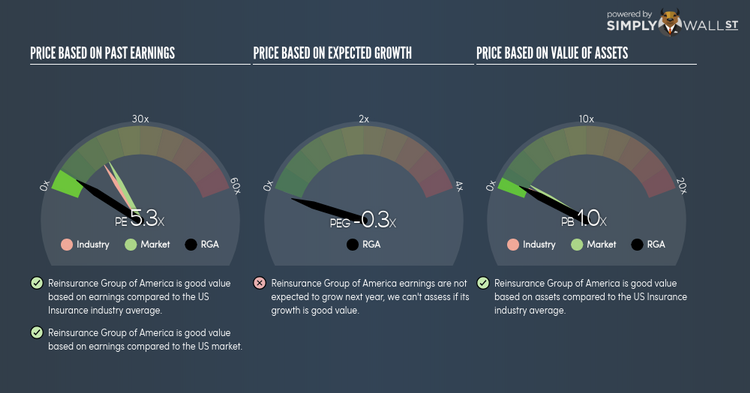Should You Be Tempted To Buy Reinsurance Group of America Incorporated (NYSE:RGA) At Its Current PE Ratio?

Reinsurance Group of America Incorporated (NYSE:RGA) trades with a trailing P/E of 5.3x, which is lower than the industry average of 15.9x. Although some investors may jump to the conclusion that this is a great buying opportunity, understanding the assumptions behind the P/E ratio might change your mind. Today, I will deconstruct the P/E ratio and highlight what you need to be careful of when using the P/E ratio. Check out our latest analysis for Reinsurance Group of America
What you need to know about the P/E ratio
The P/E ratio is one of many ratios used in relative valuation. It compares a stock’s price per share to the stock’s earnings per share. A more intuitive way of understanding the P/E ratio is to think of it as how much investors are paying for each dollar of the company’s earnings.
P/E Calculation for RGA
Price-Earnings Ratio = Price per share ÷ Earnings per share
RGA Price-Earnings Ratio = $150.61 ÷ $28.283 = 5.3x
The P/E ratio isn’t a metric you view in isolation and only becomes useful when you compare it against other similar companies. We want to compare the stock’s P/E ratio to the average of companies that have similar characteristics as RGA, such as size and country of operation. One way of gathering a peer group is to use firms in the same industry, which is what I’ll do. Since RGA’s P/E of 5.3x is lower than its industry peers (15.9x), it means that investors are paying less than they should for each dollar of RGA’s earnings. As such, our analysis shows that RGA represents an under-priced stock.
A few caveats
While our conclusion might prompt you to buy RGA immediately, there are two important assumptions you should be aware of. The first is that our “similar companies” are actually similar to RGA, or else the difference in P/E might be a result of other factors. For example, if you compared higher growth firms with RGA, then its P/E would naturally be lower since investors would reward its peers’ higher growth with a higher price. The second assumption that must hold true is that the stocks we are comparing RGA to are fairly valued by the market. If this does not hold true, RGA’s lower P/E ratio may be because firms in our peer group are overvalued by the market.
To help readers see pass the short term volatility of the financial market, we aim to bring you a long-term focused research analysis purely driven by fundamental data. Note that our analysis does not factor in the latest price sensitive company announcements.
The author is an independent contributor and at the time of publication had no position in the stocks mentioned.

